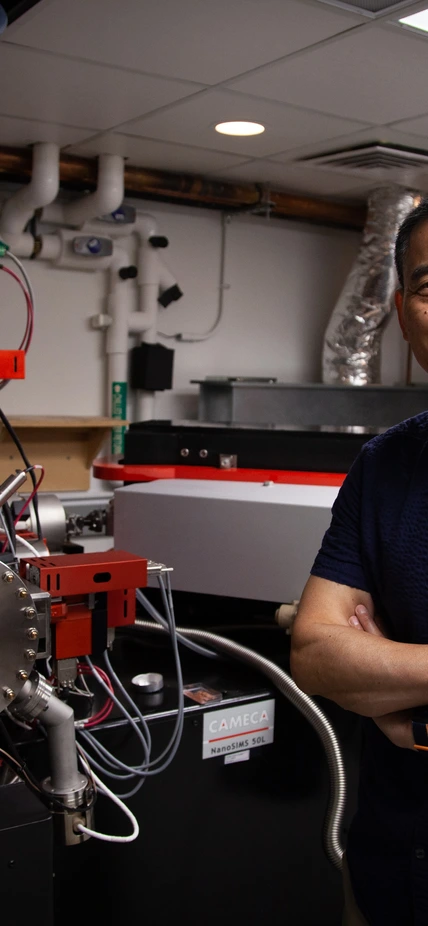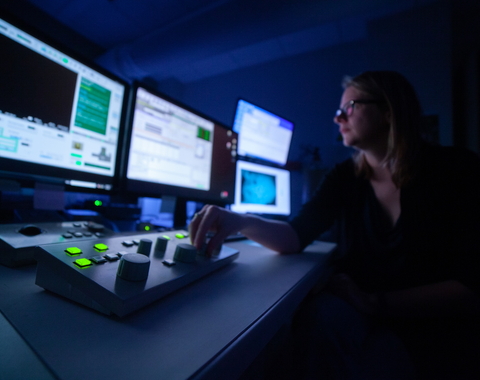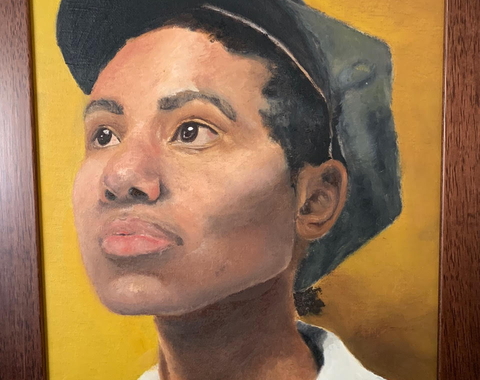Jianhua Wang has kept the SIMS lab running at the Carnegie Institution for Science Earth and Planets Laboratory for more than 25 years. As the SIMS Lab Manager and a Senior Research Scientist, he has been intimately involved with many of the historic research projects on campus, like the discovery of water on the moon or the deep cycling of materials in the Earth.In this short interview, we went behind the scenes to chat with Wang about his work and what he’s looking forward to next in geochemical research.
This interview has been edited from its original format.
1) Who are you? What do you do at the Earth and Planets Laboratory?
My name is Jianhua Wang. I am a Senior Research Scientist and the SIMS (stands for Secondary Ion Mass Spectrometer) Lab Manager at the Carnegie Institution’s Earth and Planets Laboratory.
We have two SIMS instruments (also called ion microprobes) here in our lab. One is a smaller version of the ion microprobe, a CAMECA-ims 6f, and the other one is a more sophisticated (and of course more expensive) CAMECA nanoSIMS50L.
The ion microprobes are basically mass spectrometers. My job here is to keep these machines running smoothly; assist and train users (mostly postdocs) to analyze samples (collecting data); develop new methods of analysis and conduct some research of my own interests.
2) How long have you worked at Carnegie?
I came to work at Carnegie in February of 1996, so I have been working here for over 25 years.
3) What types of projects do you work on?
The most urgent project that I am working on now is to get our 6f ion microprobe back to work. Several vacuum pumps and some electronic components failed before and during the Covid-19 pandemic. The 6f ion microprobe is over 25 years old and is considered obsolete by the manufacturer. We are lacking proper components and skills to fix its problems.
4) Do you have any favorite projects? Are you looking forward to any projects?
My favorite project that I did was measuring solar wind composition in samples from the Genesis mission. I am looking forward to a project using diamonds to study the cycling of Earth materials and primitive compositions of the Earth.
5) How does the SIMS work? What exactly does it do?
Ion microprobes (SIMS instruments) use focused high energy (high voltage) ions (primary ions) to hit/impact (sputter) target samples in areas of tens of nanometers to a few tens of micrometers.
The target material will be excavated and some of it is ionized. The ionized sample (secondary ions) will be extracted at high voltage and focused in energy and separated into different masses through the mass spectrometer. Up to 7 different masses can be detected/counted by detectors at the same time with the nanoSIMS. The most important characteristics of the ion microprobes are their high detection limits (ppm to ppb levels); high isotopic measurement precision (per ten thousand); high spatial resolution (referred to as in situ measurements) and nanometer imaging capabilities.
6) What is the biggest challenge about this work?
The ion microprobes are very complicated instruments with lots of high voltage electronic components; high vacuum; many motorized parts for automation and running under very stable temperature (+/- 1 degree). The biggest challenge about this work is that they could break/malfunction at any time.
I am probably one of the world’s experts on using this machine.
7) How did you get interested in this work?
When I did my Ph.D. at the University of Chicago, I used a very old ion microprobe to measure Mg isotopic compositions of evaporation experiments to simulate and study conditions of our early solar system. I continued to work on the more sophisticated SIMS instrument when I did a one-year postdoc at UCLA before I came to work at Carnegie. That is how I got into instrumentation. Working with ion microprobes is a challenging and fascinating job.
8) What is your favorite memory as a scientist?
My most favorite memory as a scientist is when we used these ion microprobes to get data to get a new scientific discovery such as water on the moon; the oceanic plate cycling through the deep mantle and pre-solar materials in meteorites.
9) What is one thing people might be surprised to learn about you?
That I am a great cook and I like to garden at home. I’m particularly good at a special type of Chinese red bean and egg yolk pastry.
10) Puff pastry is notorious for being hard to make. Is this pastry the nanoSIMS of baked goods?
The nanoSIMS is much more complicated!



